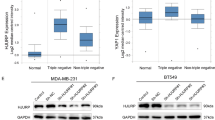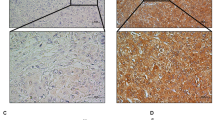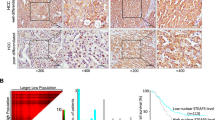Abstract
Amplified in breast cancer 1 (AIB1) is a transcriptional coactivator for nuclear receptors and other transcription factors. AIB1 has an important role in malignancy of several cancers such as breast and prostate cancers. However, its involvement in human hepatocellular carcinoma (HCC) progression remains unclear. Here, we found that AIB1 protein was overexpressed in 23 of 34 human HCC specimens (68%). Down-regulation of AIB1 reduced HCC cell proliferation, migration, invasion, colony formation ability and tumorigenic potential in nude mice. These phenotypic changes caused by AIB1 knockdown correlated with increased expression of the cell cycle inhibitor p21Cip1/Waf1 and decreased Akt activation and the expression of proliferating cell nuclear antigen (PCNA) and matrix metallopeptidase MMP-9. In agreement with these findings, clinical AIB1-positive HCC expressed higher levels of PCNA than AIB1-negative HCC. A positive correlation was established between the levels of AIB1 protein and PCNA protein in HCC, suggesting that AIB1 may contribute to HCC cell proliferation. In addition, MMP-9 expression in AIB1-postive HCC was significantly higher than that in AIB1-negative HCC, suggesting that AIB1-postive HCC may be more invasive. Collectively, our results show that overexpression of AIB1 promotes human HCC progression by enhancing cell proliferation and invasiveness. Therefore, AIB1 is a master regulator of human HCC growth and might be a useful molecular target for HCC prognosis and treatment.
This is a preview of subscription content, access via your institution
Access options
Subscribe to this journal
Receive 50 print issues and online access
$259.00 per year
only $5.18 per issue
Buy this article
- Purchase on Springer Link
- Instant access to full article PDF
Prices may be subject to local taxes which are calculated during checkout







Similar content being viewed by others
References
Adams BD, Cowee DM, White BA . (2009). The role of miR-206 in the epidermal growth factor (EGF) induced repression of estrogen receptor-alpha (ER{alpha}) signaling and a luminal phenotype in MCF-7 breast cancer cells. Mol Endocrinol 23: 1215–1230.
Anzick SL, Kononen J, Walker RL, Azorsa DO, Tanner MM, Guan XY et al. (1997). AIB1, a steroid receptor coactivator amplified in breast and ovarian cancer. Science 277: 965–968.
Arii S, Mise M, Harada T, Furutani M, Ishigami S, Niwano M et al. (1996). Overexpression of matrix metalloproteinase 9 gene in hepatocellular carcinoma with invasive potential. Hepatology 24: 316–322.
Bouras T, Southey MC, Venter DJ . (2001). Overexpression of the steroid receptor coactivator AIB1 in breast cancer correlates with the absence of estrogen and progesterone receptors and positivity for p53 and HER2/neu. Cancer Res 61: 903–907.
Chen H, Lin RJ, Schiltz RL, Chakravarti D, Nash A, Nagy L et al. (1997). Nuclear receptor coactivator ACTR is a novel histone acetyltransferase and forms a multimeric activation complex with P/CAF and CBP/p300. Cell 90: 569–580.
Chung AC, Zhou S, Liao L, Tien JC, Greenberg NM, Xu J . (2007). Genetic ablation of the amplified-in-breast cancer 1 inhibits spontaneous prostate cancer progression in mice. Cancer Res 67: 5965–5975.
Farazi PA, DePinho RA . (2006). Hepatocellular carcinoma pathogenesis: from genes to environment. Nat Rev Cancer 6: 674–687.
Henke RT, Haddad BR, Kim SE, Rone JD, Mani A, Jessup JM et al. (2004). Overexpression of the nuclear receptor coactivator AIB1 (SRC-3) during progression of pancreatic adenocarcinoma. Clin Cancer Res 10: 6134–6142.
Hossain A, Kuo MT, Saunders GF . (2006). Mir-17-5p regulates breast cancer cell proliferation by inhibiting translation of AIB1 mRNA. Mol Cell Biol 26: 8191–8201.
Hui L, Zatloukal K, Scheuch H, Stepniak E, Wagner EF . (2008). Proliferation of human HCC cells and chemically induced mouse liver cancers requires JNK1-dependent p21 downregulation. J Clin Invest 118: 3943–3953.
Kajiro M, Hirota R, Nakajima Y, Kawanowa K, So-ma K, Ito I et al. (2009). The ubiquitin ligase CHIP acts as an upstream regulator of oncogenic pathways. Nat Cell Biol 11: 312–319.
Kim D, Kim S, Koh H, Yoon SO, Chung AS, Cho KS et al. (2001). Akt/PKB promotes cancer cell invasion via increased motility and metalloproteinase production. FASEB J 15: 1953–1962.
Kitamoto M, Nakanishi T, Kira S, Kawaguchi M, Nakashio R, Suemori S et al. (1993). The assessment of proliferating cell nuclear antigen immunohistochemical staining in small hepatocellular carcinoma and its relationship to histologic characteristics and prognosis. Cancer 72: 1859–1865.
Kuang SQ, Liao L, Wang S, Medina D, O′Malley BW, Xu J . (2005). Mice lacking the amplified in breast cancer 1/steroid receptor coactivator-3 are resistant to chemical carcinogen-induced mammary tumorigenesis. Cancer Res 65: 7993–8002.
Kuang SQ, Liao L, Zhang H, Lee AV, O'Malley BW, Xu J . (2004). AIB1/SRC-3 deficiency affects insulin-like growth factor I signaling pathway and suppresses v-Ha-ras-induced breast cancer initiation and progression in mice. Cancer Res 64: 1875–1885.
Li H, Gomes PJ, Chen JD . (1997). RAC3, a steroid/nuclear receptor-associated coactivator that is related to SRC-1 and TIF2. Proc Natl Acad Sci USA 94: 8479–8484.
Liang JA, Wu SL, Lo HY, Hsiang CY, Ho TY . (2009). Vanillin inhibits matrix metalloproteinase-9 expression through down-regulation of nuclear factor-kappaB signaling pathway in human hepatocellular carcinoma cells. Mol Pharmacol 75: 151–157.
Llovet JM, Bruix J . (2008). Molecular targeted therapies in hepatocellular carcinoma. Hepatology 48: 1312–1327.
Llovet JM, Ricci S, Mazzaferro V, Hilgard P, Gane E, Blanc JF et al. (2008). Sorafenib in advanced hepatocellular carcinoma. N Engl J Med 359: 378–390.
Louie MC, Zou JX, Rabinovich A, Chen HW . (2004). ACTR/AIB1 functions as an E2F1 coactivator to promote breast cancer cell proliferation and antiestrogen resistance. Mol Cell Biol 24: 5157–5171.
Ma WL, Hsu CL, Wu MH, Wu CT, Wu CC, Lai JJ et al. (2008). Androgen receptor is a new potential therapeutic target for the treatment of hepatocellular carcinoma. Gastroenterology 135: 947–955, 955 e941-945.
Mussi P, Yu C, O'Malley BW, Xu J . (2006). Stimulation of steroid receptor coactivator-3 (SRC-3) gene overexpression by a positive regulatory loop of E2F1 and SRC-3. Mol Endocrinol 20: 3105–3119.
Nakanishi K, Sakamoto M, Yamasaki S, Todo S, Hirohashi S . (2005). Akt phosphorylation is a risk factor for early disease recurrence and poor prognosis in hepatocellular carcinoma. Cancer 103: 307–312.
Oh A, List HJ, Reiter R, Mani A, Zhang Y, Gehan E et al. (2004). The nuclear receptor coactivator AIB1 mediates insulin-like growth factor I-induced phenotypic changes in human breast cancer cells. Cancer Res 64: 8299–8308.
Qin L, Liao L, Redmond A, Young L, Yuan Y, Chen H et al. (2008). The AIB1 oncogene promotes breast cancer metastasis by activation of PEA3-mediated matrix metalloproteinase 2 (MMP2) and MMP9 expression. Mol Cell Biol 28: 5937–5950.
Sakakura C, Hagiwara A, Yasuoka R, Fujita Y, Nakanishi M, Masuda K et al. (2000). Amplification and over-expression of the AIB1 nuclear receptor co-activator gene in primary gastric cancers. Int J Cancer 89: 217–223.
Sato H, Seiki M . (1993). Regulatory mechanism of 92 kDa type IV collagenase gene expression which is associated with invasiveness of tumor cells. Oncogene 8: 395–405.
Sherr CJ, Roberts JM . (1999). CDK inhibitors: positive and negative regulators of G1-phase progression. Genes Dev 13: 1501–1512.
Tan JA, Hall SH, Petrusz P, French FS . (2000). Thyroid receptor activator molecule, TRAM-1, is an androgen receptor coactivator. Endocrinology 141: 3440–3450.
Thaler S, Hahnel PS, Schad A, Dammann R, Schuler M . (2009). RASSF1A mediates p21Cip1/Waf1-dependent cell cycle arrest and senescence through modulation of the Raf-MEK-ERK pathway and inhibition of Akt. Cancer Res 69: 1748–1757.
Torchia J, Rose DW, Inostroza J, Kamei Y, Westin S, Glass CK et al. (1997). The transcriptional co-activator p/CIP binds CBP and mediates nuclear-receptor function. Nature 387: 677–684.
Torres-Arzayus MI, Font de Mora J, Yuan J, Vazquez F, Bronson R, Rue M et al. (2004). High tumor incidence and activation of the PI3K/AKT pathway in transgenic mice define AIB1 as an oncogene. Cancer Cell 6: 263–274.
Wang Y, Wu MC, Sham JS, Zhang W, Wu WQ, Guan XY . (2002). Prognostic significance of c-myc and AIB1 amplification in hepatocellular carcinoma. A broad survey using high-throughput tissue microarray. Cancer 95: 2346–2352.
Wang Z, Rose DW, Hermanson O, Liu F, Herman T, Wu W et al. (2000). Regulation of somatic growth by the p160 coactivator p/CIP. Proc Natl Acad Sci USA 97: 13549–13554.
Werbajh S, Nojek I, Lanz R, Costas MA . (2000). RAC-3 is a NF-kappa B coactivator. FEBS Lett 485: 195–199.
Xie D, Sham JS, Zeng WF, Lin HL, Bi J, Che LH et al. (2005). Correlation of AIB1 overexpression with advanced clinical stage of human colorectal carcinoma. Hum Pathol 36: 777–783.
Xu J, Li Q . (2003). Review of the in vivo functions of the p160 steroid receptor coactivator family. Mol Endocrinol 17: 1681–1692.
Xu J, Liao L, Ning G, Yoshida-Komiya H, Deng C, O′Malley BW . (2000). The steroid receptor coactivator SRC-3 (p/CIP/RAC3/AIB1/ACTR/TRAM-1) is required for normal growth, puberty, female reproductive function, and mammary gland development. Proc Natl Acad Sci USA 97: 6379–6384.
Xu J, Wu RC, O′Malley BW . (2009). Normal and cancer-related functions of the p160 steroid receptor co-activator (SRC) family. Nat Rev Cancer 9: 615–630.
Yan J, Erdem H, Li R, Cai Y, Ayala G, Ittmann M et al. (2008). Steroid receptor coactivator-3/AIB1 promotes cell migration and invasiveness through focal adhesion turnover and matrix metalloproteinase expression. Cancer Res 68: 5460–5468.
Yan J, Yu CT, Ozen M, Ittmann M, Tsai SY, Tsai MJ . (2006). Steroid receptor coactivator-3 and activator protein-1 coordinately regulate the transcription of components of the insulin-like growth factor/AKT signaling pathway. Cancer Res 66: 11039–11046.
Yu C, Wang F, Jin C, Huang X, Miller DL, Basilico C et al. (2003). Role of fibroblast growth factor type 1 and 2 in carbon tetrachloride-induced hepatic injury and fibrogenesis. Am J Pathol 163: 1653–1662.
Zhou G, Hashimoto Y, Kwak I, Tsai SY, Tsai MJ . (2003). Role of the steroid receptor coactivator SRC-3 in cell growth. Mol Cell Biol 23: 7742–7755.
Zhou HJ, Yan J, Luo W, Ayala G, Lin SH, Erdem H et al. (2005). SRC-3 is required for prostate cancer cell proliferation and survival. Cancer Res 65: 7976–7983.
Acknowledgements
We thank Dr Li Qin for the MMP-9-promoter/reporter plasmid and Dr Jianming Xu for critical reading of the article. This work was supported by Grants from National Basic Research Program of China (973 Program, 2008CB517311 and 2009CB522200), National Natural Science Foundation of China (30600566 and 30770455), 111 Project (06016), and the Science Planning Program of Fujian Province (2009J1010).
Author information
Authors and Affiliations
Corresponding author
Ethics declarations
Competing interests
The authors declare no conflict of interest.
Additional information
Supplementary Information accompanies the paper on the Oncogene website
Supplementary information
Rights and permissions
About this article
Cite this article
Xu, Y., Chen, Q., Li, W. et al. Overexpression of transcriptional coactivator AIB1 promotes hepatocellular carcinoma progression by enhancing cell proliferation and invasiveness. Oncogene 29, 3386–3397 (2010). https://doi.org/10.1038/onc.2010.90
Received:
Revised:
Accepted:
Published:
Issue Date:
DOI: https://doi.org/10.1038/onc.2010.90
Keywords
This article is cited by
-
Targeting the NCOA3-SP1-TERT axis for tumor growth in hepatocellular carcinoma
Cell Death & Disease (2020)
-
Steroid receptor coactivator 3 inhibits hepatitis B virus gene expression through activating Akt signaling to prevent HNF4α nuclear translocation
Cell & Bioscience (2019)
-
RAC3 influences the chemoresistance of colon cancer cells through autophagy and apoptosis inhibition
Cancer Cell International (2017)
-
Histone demethylase JMJD1A promotes urinary bladder cancer progression by enhancing glycolysis through coactivation of hypoxia inducible factor 1α
Oncogene (2017)
-
Histone acetyl transferase GCN5 promotes human hepatocellular carcinoma progression by enhancing AIB1 expression
Cell & Bioscience (2016)



